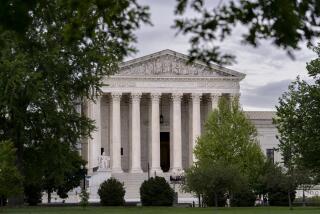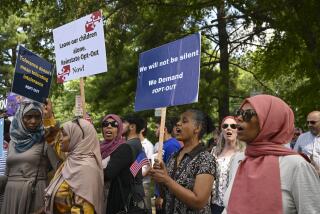High Court Goes Cold on Religious Liberty : Law: The tone is entirely one of limitation, as though the free exercise of religion is a danger to be closely confined.
- Share via
The Supreme Court ruled last week that since Oregon could prohibit the religious use of the hallucinogenic drug, peyote, it could deny unemployment compensation to persons discharged for such use. Thus stated, the decision appears unremarkable. In fact, the court’s opinion opens up a constitutional fault of San Andreas proportions.
Many times before, the Supreme Court, and all lower courts, have issued rulings telling us that our First Amendment freedoms are not absolute. When my speech is sufficiently incendiary, or when your assembled followers become an unmanageable mob, the common good may require me to shut up, and you to disband your crowd.
So, too, with religion. A century ago, the Supreme Court said that if a religion calls for human sacrifice, the First Amendment’s free exercise (of religion) clause does not protect such a practice. Polygamy could be made a crime, even though, to Mormons, it was religiously required. Child labor laws could prohibit a Jehovah’s Witness from using her small child to hawk religious tracts on city streets. In all of these cases, the common good--protection of life, protection of the family, protection of children--was deemed a barrier to the religious practice in question.
But the Supreme Court, from the early 1940s on, had insisted that the freedoms of religion, speech, press and assembly were “preferred” freedoms--fundamental and precious--unlike, for example, freedom of contract or economic liberties.
What practical difference does it make to say that First Amendment liberties are “preferred”? An enormous difference. A law restricting an “ordinary” liberty--such as the local zoning ordinance that forbids you to put a garage on your side yard--will be upheld by the courts if they can find that the ordinance has some possible reasonable basis for this restriction on your use of your property. But suppose an ordinance forbids citizens to circulate leaflets attacking the city government. Constitutionally (so we have always understood) that’s a wholly different ball game. Your free-press rights to circulate the leaflets can’t be denied unless the government can prove that a “compelling state interest” (a supreme societal interest) justifies the leaflet ban. Just finding some “reasonable basis” for restricting your press rights won’t do.
Further, the Supreme Court had held that it is up to government to prove with credible facts that its interest is “compelling.” That rule made sense. Those who assert precious First Amendment liberties are usually at a disadvantage when government seeks to infringe upon those liberties. Government, in such contests, usually has the edge economically, in attorney manpower--and sometimes politically. As Charles Dickens noted in “Bleak House,” legal processes have enormous potential for “wearying out the right.” Hence, where our most basic liberties are concerned, it is essential that our courts not only invoke the standard of “compelling state interest” but that they make government prove it.
Last Tuesday, all of that changed. In the peyote case, involving American Indian religious practices, the Supreme Court expressly jettisoned the “compelling state interest” test. It held that in this and future cases, no “compelling state interest” need justify government action against religion. With two narrow exceptions, generally applicable prohibitions of conduct which government deems to be “socially harmful” must be upheld against objections based on religion. The first is the imaginary case posited by the court in which government expressly bans the performance of a specific religious act. The court here mentions (oddly, in this peyote case) “participating in the sacramental use of . . . wine.” The second is where religiously motivated action has involved not only the free exercise clause but some other constitutional protection, such as freedom of speech or press. This second “hybrid situation” exception takes religious liberty from its high place in the Bill of Rights, giving it scope only if it is attached to some other right.
Where does this lead?
It moves the principle of religious liberty, as given in the First Amendment, to the back of the constitutional bus--maybe off the bus. The court deems free exercise to be a free-standing right only in the improbable situation in which government singles out some religious practice as forbidden. If a prohibitory law is “generally applicable,” too bad for religious interests that get in the way of it. Hence, the wage-and-hour prohibitions of a labor relations act could be applied to work done by clergy under vows of poverty. And since the court’s reasoning is broad enough to include mandatory as well as prohibitory laws, religious schools could be required to be carbon copies of public schools.
The court’s opinion is strikingly cold in reference to religion. It has not a good word to say for the traditional glory of American religious liberty. The tone is entirely one of limitation and curbing, as though the free exercise of religion were a danger to be closely confined or is of little greater significance than the rampant exercise of whim. The court has used a trivial circumstance as the vehicle for a catastrophic decision. It is tragic that it utilized this case to create a precedent that will govern future cases involving churches, religious schools, clergy, ministries--indeed, the future religious life of the nation.
More to Read
Sign up for Essential California
The most important California stories and recommendations in your inbox every morning.
You may occasionally receive promotional content from the Los Angeles Times.













